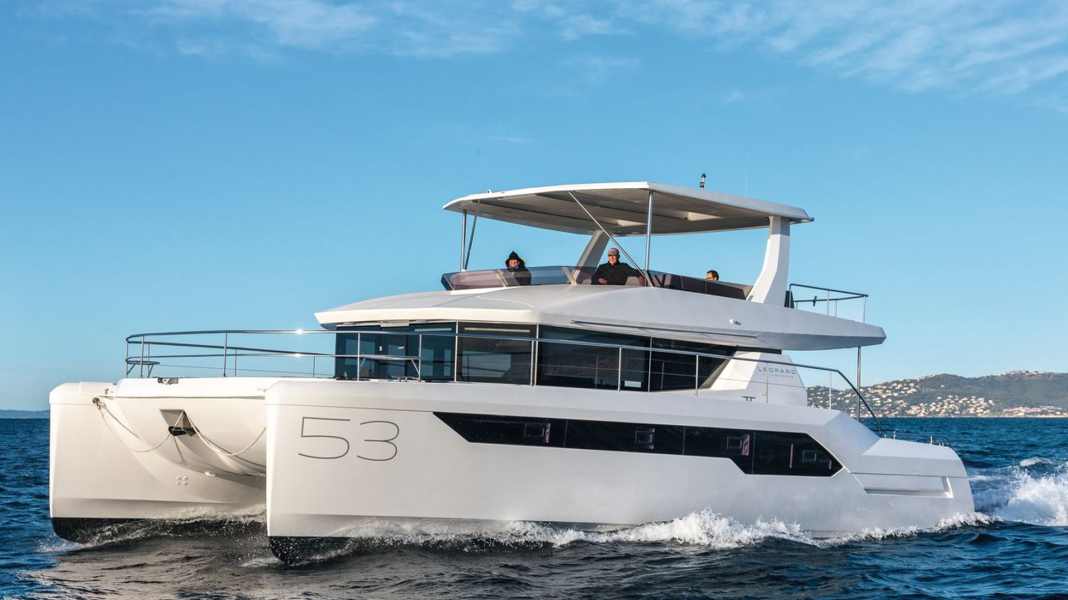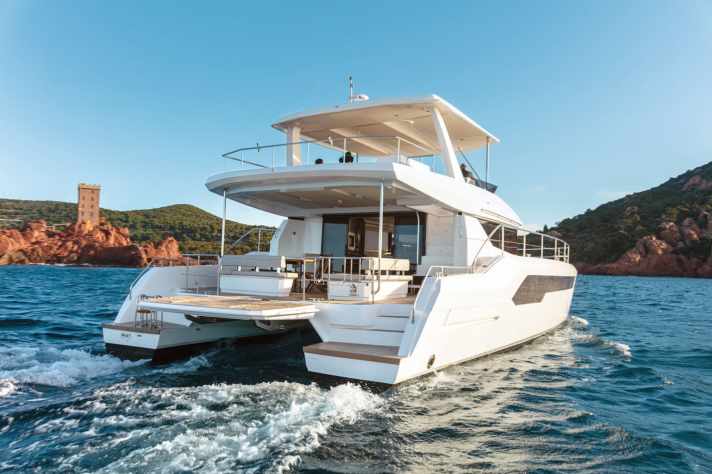Test: Motorised catamaran - Leopard 53 Powercat

The Côte d'Azur presents itself from its very best side during the test: picture postcard weather, flat water, very little wind. The new Leopard 53 is waiting in the harbour of Saint-Raphaël and its strongest argument becomes apparent as soon as you step aboard the catamaran: the generous amount of space. Surprisingly, boarding is not facilitated by an opening in the railing - if you want to get on deck from the side, you have to climb up - but once on board, the freedom of movement is overwhelming. There are four zones for relaxing: the bow with two sunbathing areas, the cockpit with an L-shaped bench seat and a large table as well as a separate chaise longue, the flybridge with a steering position, additional seating and lounging options as well as an outdoor pantry and finally the spacious saloon.
Need more information? You can find the test of the Leopard 53 Powercat with technical data and more pictures in BOOTE issue 08/2021 from 14/07/2021 at newsstands or online at Delius Klasing Shop.
For Pierre-Yves Chanau, the Leopard 53 Powercat is a milestone. "Our first motorboat catamarans almost ten years ago were simply sailboats without masts. Later, we changed a lot more, but we still started from the successful sailboat catamarans. The 53 Powercat is now the first pure motorboat! Apart from the typical Leopard design language, it has nothing in common with a sailing boat," says the Head of Marketing Europe. As a result of the new approach, Alex Simonis from Simonis-Voogd-Design - the office responsible for all Leopard catamarans - names three eye-catching, motorboat-specific aspects: the steering position in the saloon, the new, large engine compartments and the windscreen on the flybridge.

In contrast to earlier Leopard Powercats, the steering position in the saloon is fully equipped with all control units and displays. In bad weather, the skipper can therefore easily stay in the sheltered and warm saloon. Only during manoeuvres is it advisable to go to the flybridge in any case: the overview up here is significantly better. Speaking of which: the helm station on the flybridge with a bench seat for the driver and co-driver, as well as the additional bench seat on the port side, is now a pleasantly sheltered place even during longer manoeuvres - thanks to the hardtop and the new windscreen.
The Leopard 53 Powercat is powered by two common-rail engines from Yanmar. The two 8-cylinder diesels each deliver 370 hp to the shaft. Around 3000 rpm is required for a stable journey, at which point the boat reaches a cruising speed of 15 knots. The maximum speed is 22 knots (3800 rpm); for a more economical cruising style, the boat is content with around 8.5 knots. With a tank capacity of 1980 litres, an autonomy of 1241 nautical miles at half load is possible according to the shipyard.

All Leopard catamarans are built at the South African shipyard Robertson & Caine. The successful collaboration began in the 1990s when the global charter company Moorings was looking for a shipyard for its new fleet of catamarans. Following positive experiences and in response to growing customer demand, the first Powercat was launched in 2002. The success proved those responsible right: for example, more than 130 units of the predecessor model launched in 2014, the 51 Powercat, were produced.
Leopard belongs to Travelopia - just like The Moorings and Sunsail. In recent years, around 50 per cent of all Leopard catamarans have been sold to private owners, while the others have been chartered as part of owner programmes. To cater for different needs, the Leopard 53 Powercat is available in two versions: with four cabins and four heads or three cabins and three heads, with the three-cabin version offering a spacious owner's suite in the starboard hull. A crew cabin can be added to both configurations. In general, the hulls offer plenty of volume in the cabins thanks to the pronounced chines, and the continuous windows allow plenty of light into the interior.

The advantages of a catamaran naturally come into their own in the saloon: some 60-foot yachts offer less space and view than the 53 Powercat. In addition, the large galley with its direct access to the cockpit allows the different roles on board to be mixed: preparing and then enjoying a sundowner is possible without anyone having to stew away from the party as a smutje.
Need more information? You can find the test of the Leopard 53 Powercat with technical data and more pictures in BOOTE issue 08/2021 from 14/07/2021 at newsstands or online at Delius Klasing Shop.

